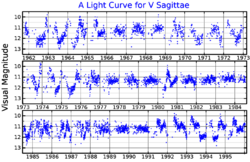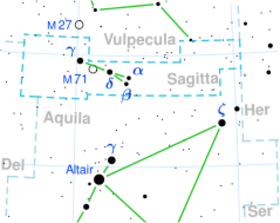Astronomy:V Sagittae
| Observation data Equinox J2000.0]] (ICRS) | |
|---|---|
| Constellation | Sagitta |
| Right ascension | 20h 20m 14.691s[1] |
| Declination | +21° 06′ 10.44″[1] |
| Apparent magnitude (V) | 8.6-13.9[2] |
| Characteristics | |
| Variable type | eclipsing and cataclysmic[2] |
| Astrometry | |
| Proper motion (μ) | RA: −2.052[1] mas/yr Dec.: −6.485[1] mas/yr |
| Parallax (π) | 0.4190 ± 0.0320[1] mas |
| Distance | 7,800 ± 600 ly (2,400 ± 200 pc) |
| Absolute magnitude (MV) | −2.2[3] |
| Orbit[4] | |
| Semi-major axis (a) | 4.36 R☉ |
| Inclination (i) | 71° |
| Semi-amplitude (K1) (primary) | 320 km/s |
| Semi-amplitude (K2) (secondary) | 85 km/s |
| Details | |
| Mass | 0.9[4] M☉ |
| Radius | 1.2[4] R☉ |
| Luminosity | 30,000[4] L☉ |
| Temperature | 70,000[4] K |
| Mass | 3.3[4] M☉ |
| Radius | 2.1[4] R☉ |
| Temperature | 12,000[4] K |
| Other designations | |
AAVSO 1015+20, V Sge, GSC 01643-01764 | |
| Database references | |
| SIMBAD | data |
V Sagittae or V Sge is a cataclysmic variable red giant star in the constellation Sagitta that went nova in 5745 BCE and briefly become the most luminous point of light in the Milky Way and one of the brightest stars in our sky between the years 2067 and 2099.[5][6] The system is composed of a main sequence star of about 3.3 solar masses and a white dwarf of about 0.9 solar masses; the fact that the white dwarf is less massive than its companion is highly unusual,[5] and V Sge is the only super soft X-ray source nonmagnetic cataclysmic variable found so far.

V Sge has brightened by a factor of 10 since the 1890s, and based on research reported in 2020, it is expected to continue to brighten and briefly become the brightest star in the night sky sometime between years 2067 and 2099.[8] Over the past 7,768 years the pair has coalesced and went nova, eventually becoming a red giant star.
Until they went nova, the stars orbited each other about every 0.514 days, and eclipsed each other each orbit. The pair is currently viewed in the late stages of their spiral in. Their orbital period currently decreases by 4.73 * 10−10 days per cycle, a rate which will accelerate.
Material from the larger star is accreting onto the white dwarf at an exponentially increasing rate, generating a huge stellar wind. The doubling time for the accretion rate, and hence for the system luminosity, is about 89±11 years.[3]
References
- ↑ 1.0 1.1 1.2 1.3 1.4 Brown, A. G. A. (August 2018). "Gaia Data Release 2: Summary of the contents and survey properties". Astronomy & Astrophysics 616: A1. doi:10.1051/0004-6361/201833051. Bibcode: 2018A&A...616A...1G. Gaia DR2 record for this source at VizieR.
- ↑ 2.0 2.1 Samus, N. N. et al. (2009). "VizieR Online Data Catalog: General Catalogue of Variable Stars (Samus+ 2007-2013)". VizieR On-line Data Catalog: B/GCVS. Originally Published in: 2009yCat....102025S 1: B/gcvs. Bibcode: 2009yCat....102025S.
- ↑ 3.0 3.1 "V Sagittae technical details". https://www.lsu.edu/physics/files/v_sagittae/vsge_technical-details.pdf.
- ↑ 4.0 4.1 4.2 4.3 4.4 4.5 4.6 4.7 Smak, Jozef I.; Belczynski, K.; Zola, S. (2001). "V Sge: A Hot, Peculiar Binary System". Acta Astronomica 51: 117. Bibcode: 2001AcA....51..117S.
- ↑ 5.0 5.1 "Binary star V Sagittae to explode as very bright nova by century's end" (in en-us). https://phys.org/news/2020-01-binary-star-sagittae-bright-nova.html.
- ↑ "CNN - Breaking News, Latest News and Videos". http://m.cnn.com/en/article/h_f7a7fda778b24834ac5316152cc63433.
- ↑ Šimon, V.; Mattei, J. A. (October 1999). "The peculiar binary V Sagittae: Properties of its long-term light changes". Astronomy and Astrophysics Supplement Series 139: 75–88. doi:10.1051/aas:1999381. Bibcode: 1999A&AS..139...75S.
- ↑ "235th AAS Session Meeting Abstracts Table of Contents". 2020-01-02. https://aas.org/sites/default/files/2020-01/AAS235-Meeting-Abstracts.pdf.
 |


